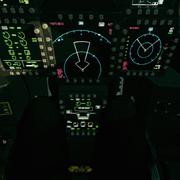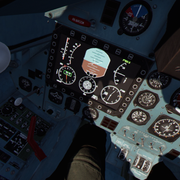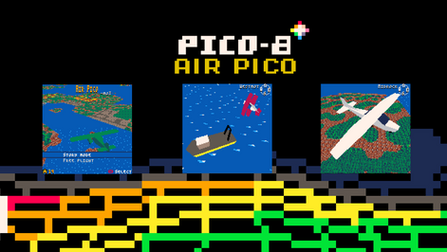New Dimension of Appreciation, the Ace Combat 7 Virtual Reality Experience
- Aaron "Ribbon-Blue" Mendoza

- Nov 6, 2019
- 6 min read
Updated: Oct 9, 2022
In the grand scheme of things, if the primary complaint is that people wanted more, something must have been done right.

The addition of virtual reality (VR) for Ace Combat 7: Skies Unknown brings with it a new dimension of appreciation. It is a chance to acknowledge the minor details, physical restraints, and technological advancement in aircraft cockpits. Digital aviators on personal computers have had access to virtual reality for years, but thanks to the combination of the Sony PlayStation 4 and its VR headset, console gamers are now experiencing the thrill of VR aviation. For Ace Combat specifically, VR is both a milestone and a potential building block.
The successful introduction of virtual reality to Ace Combat 7: Skies Unknown is a huge step forward for the Ace Combat series, no doubt.
As said by Kazutoki Kono during our interview with him at PAX South 2019, successfully developing a full game with new staff members and a new organizational structure was a hurdle all on its own. Add to that the fact that Project Aces - the team creating the Ace Combat series - had no experience with virtual reality. VR development regained speed when VR Producer Jun Tamaoki joined the team and took control of the process. More information about this is available in the words of Project Aces staff in the second developer diary for Ace Combat 7.
The final product of the virtual reality component for the latest Ace Combat title on the PlayStation 4 has primarily received positive feedback, leaning on the side of overwhelmingly successful. The main knock against it is how quickly the experience is over. In the grand scheme of things, if the primary complaint is that people wanted more, something must have been done right. Truthfully, the discovery of unused VR mission data found by data mining does sting a bit. This data shows that the campaign could have been expanded from three to six missions. The increased mission count may have extended it from a VR experience to at least a small VR campaign allows the side story of AC7 VR to be fleshed out a bit more. Kazutoki Kono has addressed the possibility, requirements, and changes needed to create a full virtual reality game for the Ace Combat series multiple times by now. What the future holds is unknown, but AC7 VR has already made an immediate impact.

At the direction of the Ace Combat brand series manager, two parameters were set onto VR development:
Restricting players to cockpit only point of view
Expert flight controls
While such restrictions would generally seem a bit strict for this popular arcade flight shooter series, they contribute to the level of immersion virtual reality presents. Even when using the PlayStation 4 Dual Shock controller, finding one's self sitting in the full cockpit of multi-million dollar combat aircraft having to fly with the most realistic controls possible solidified the experience. The restrictions add a particular type of gravity to everything one does in the game. Even the seemingly repetitive things like firing a missile, evading anti-aircraft fire and landing the aircraft is more engaging. Some specific examples come to mind: The effect of aircraft icing over while flying in clouds for an extended time is especially amplified since there is no other point of view to switch to. Once the canopy is iced over, the player's vision heavily impaired. Other weather effects like moisture streaking across the canopy and hearing the aircraft rattle through turbulence contributes to the overall immersion.

The restrictions are most evident but appreciated during the process of having to physically and visually track enemies. The amount of head turning and body repositioning needed drives home the convenience of the Camera Tracking function available on a single button on a game controller. The twisting and turning sort of reminds digital aviators of just a bit of the rigor actual fighter pilots go through in training and combat. Certain special weapons have an enhanced lock on capability that are utilized by the virtual reality headset. These weapons are capable of being fired at targets to the rear or sides of the aircraft. Areas that a majority of the weapons in the non-VR modes of Ace Combat 7 cannot attack strike enemies, with the exception of the Quick Maneuver Air-to-Air Missile (QAAM). These enhanced weapons are able to do this because the VR headset is emulating a Helmeted Mounted Display with high off bore-sight tracking ability. Real world technology deployed by combat aircraft of many real world nations to gain an advantage in short range air-to-air combat. This translates to AC7 VR by giving the player the ability to look over their shoulder and attack targets without having to physically maneuver the aircraft so it has the nose pointed at the target.
Great First Impression
The first impression of AC7 VR is a good one. The decision to make the Boeing F/A-18F Super Hornet the only available aircraft when playing for the first time is a well-calculated move. Flying the first mission using the Super Hornet allows the player to complete an air defense mission from an aircraft carrier. From being raised to the aircraft carrier deck on an elevator to battling enemies high in the clouds and lining up the carrier deck for a landing.
Virtual Reality Oasis explains in the video below:
As Ace Combat continues to crank up its visual quality with each release, so too does the detail within the aircraft cockpits. Aircraft buttons are sharper, text on screens are clearer, and weather effects on the canopy are forefront. The multi-function displays and gauges within the cockpits gradually gain more movement and function in the newer titles, but a majority of the needed information is present in the ever available game overlay. In VR, cockpit design becomes more critical than ever before. Functionality begins to outweigh form and visual appeal immediately. As downright badass flying the A-10 Thunderbolt II is, the more bars, displays, and gauges that take up visual space in the cockpit, the more complicated things can get. In a series like Ace Combat where within visual range combat is emphasized, this is especially true. Flying missions using the four aircraft available allows the player to get a basic understanding for which parts of a cockpit's design are truly useful.
The information displayed within the aircraft can be toggled by pressing R3 on the PlayStation 4 Dual Shock controller. The multi-function displays (MFD) rotate information between the more realistic data and the traditional Ace Combat info: radar, weapons systems, countermeasure status, and aircraft damage status. To clarify, the MFDs in single player and multiplayer cockpits usually show info closer to what their real-world counterparts would. Image galleries that show this are at the bottom of this article.

Free Flight mode has allowed players to enjoy the freedom of flight and go sightseeing in the game since its introduction in Ace Combat 04 (2001). With no enemies attempting to shoot the player down, they are free to practice maneuvers and wander the maps looking for unique landmarks. In virtual reality, Free Flight mode provides ample time to twist and turn in the aircraft cockpits to appreciate all the detail put into them.
Aircraft still come equipped with weapons, but this game mode disables the 360 HUD and helmet mounted display. By being forced to use the aircraft's cockpit mounted HUD and reading the instrumental panels and MFDs for other needed data related to navigation; a final layer of immersion. With less info filling the field of vision constantly and the need to glance down at aircraft instrumentation from time to time, a slightly deeper sense of fulfillment can be found. The inclusion of virtual reality for Ace Combat 7: Skies Unknown is, without a doubt, a success for its developers and the series. It has opened a new sky of possibilities for the series' future and has piqued the interest of a new wave of fans awaiting the next VR experience from the next Ace Combat title.
Image Galleries
A-10C Thunderbolt II
F/A-18F Super Hornet
F-22A Raptor
Su-30M2 Flanker
About the Writer
Aaron "Ribbon-Blue" Mendoza

Co-founder of Skyward Flight Media. A lifelong aviation enthusiast with a special interest in flight simulators and games. After founding Electrosphere.info, the first English Ace Combat database, he has been involved in creating aviation related websites, communities, and events since 2005. He continues to explore past and present flight games and sims with his extensive collection of game consoles and computers. | Twitter | Discord: RibbonBlue#8870 |








































































.png)